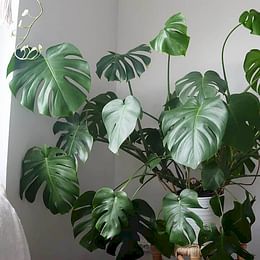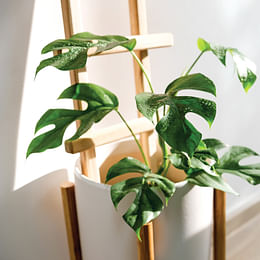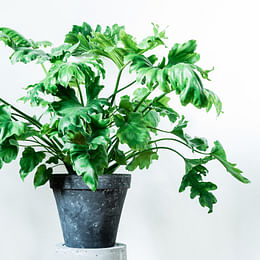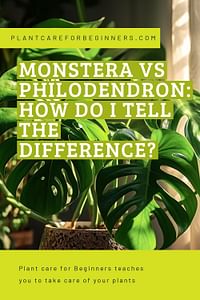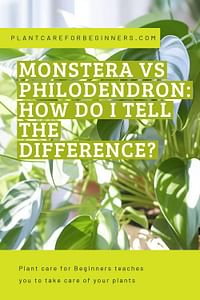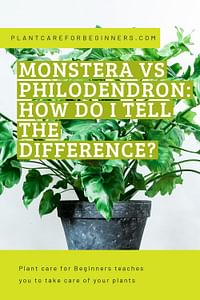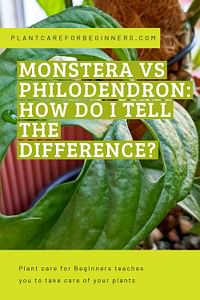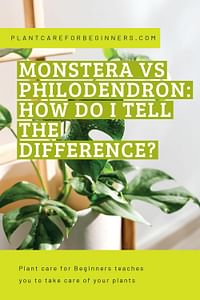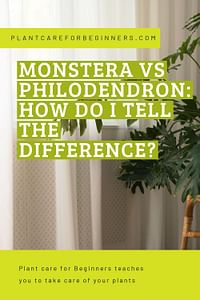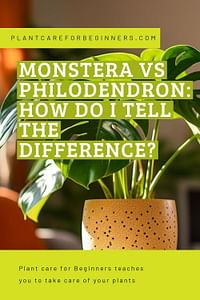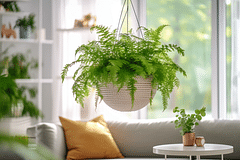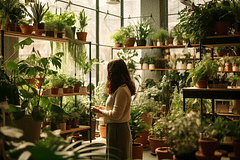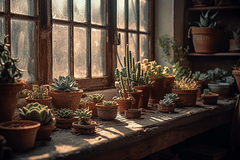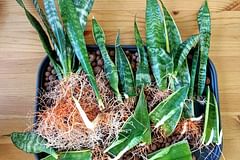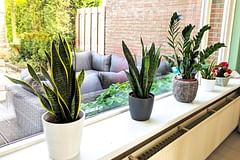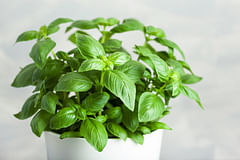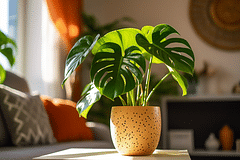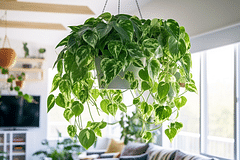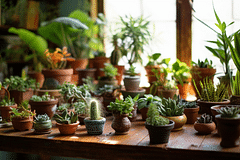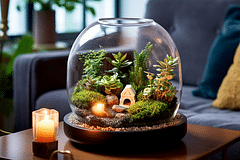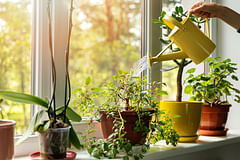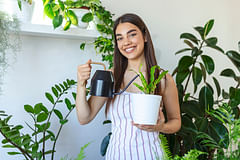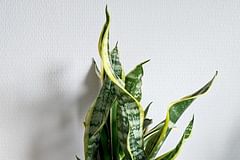Monstera vs Philodendron: How do I tell the difference?
Are you confused whether you've got a Philodendron or a Monstera? These plants are very similar, but in looks and care requirements. In this plant care guide, we'll show you the difference between the plants and we'll look at some common misidentifications of Monsteras and Philodendrons.
Last updated on:
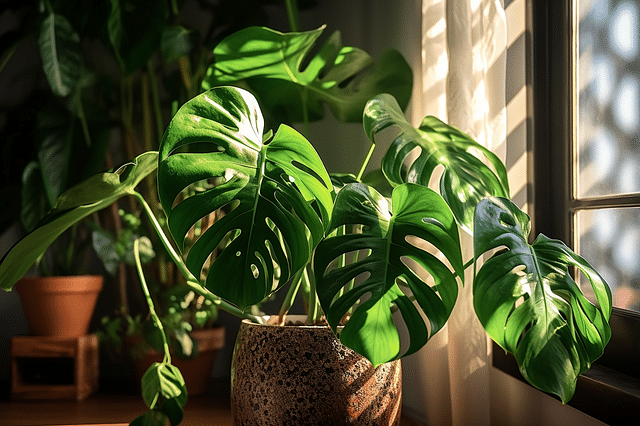 Ever looked at your broad-leafed houseplant and asked, "Are you a Monstera or a Philodendron?" Well, you're not alone. This happens to be one of the most common houseplant questions that confuse plant owners.
Ever looked at your broad-leafed houseplant and asked, "Are you a Monstera or a Philodendron?" Well, you're not alone. This happens to be one of the most common houseplant questions that confuse plant owners.
It's almost as if these two plants are playing a never-ending game of 'Hide and Seek' with us. They look a lot alike and require very similar care, but they are different plants.
So, for all of you who are confused about whether you have a Monstera or a Philodendron, I've prepared a handy guide that'll help you figure out which one is which.
In this plant care guide, we'll look at these topics together:
Let's embark on this journey and dive into the intriguing world of Monstera and Philodendron.
Understanding the Basics
Monstera and Philodendron plants have much in common! They both belong to the Araceae family and love warm, humid conditions like those found in the tropical parts of the Americas. Their appearances are quite similar too. But don't worry, there are easy clues to help you tell each plant apart from the other.
Characteristics of a Monstera
- Fenestrations: Monstera plants, especially the popular Monstera Deliciosa, are well known for their mature leaves having fenestrations, or natural holes and slits. This looks a little like "Swiss cheese".
- Leaf Edges and Texture: Monstera leaves are a more rugged, textured surface, and the edges of the leaf are wavy or ridged.
- Growth Habit: Monstera plants are typically climbing or vining plants that use aerial roots to anchor themselves onto surfaces or other plants.
- Fruit: Certain species of Monstera, like the Monstera Deliciosa, produce a fruit that looks somewhat like a green cob of corn.
Characteristics of a Philodendron
- Leaf Shape: Many Philodendrons have heart-shaped leaves, especially when they're younger. As they grow older, the leaf shape can become more diverse, but they won't get the natural holes in the leaves.
- Leaf Edges and Texture: Philodendron leaves are typically smooth and glossy, with a more uniform texture and a lack of ridges along the leaf edges.
- Growth Habit: While some Philodendrons are also vining plants like Monsteras, others grow more upright.
- Roots: Philodendrons also have aerial roots, but these are often thicker and more prominent than those of Monstera.
The Importance of Scientific Names
The biggest confusion about the "Monstera vs Philodendron" question comes from the common plant names that people have given their beautiful plants.
For example, the Philodendron Swiss Cheese plant is not a Philodendron at all, but a monstera. And the Split-leaf Philodendron is easily confused with a Monstera Deliciosa or a Thaumatophyllum bipinnatifidum.
So to help solve some of the confusion at the beginning of this plant care guide, I'll show you a table with the scientific name of each plant I'll talk about in this guide and their more commonly known names.
| Scientific Name | Common Name(s) |
|---|---|
| Monstera deliciosa | Monstera, Split-Leaf Philodendron, Swiss Cheese Plant |
| Monstera adansonii | Swiss Cheese Vine, Philodendron Swiss Cheese |
| Rhaphidophora tetrasperma | Mini Monstera, Philodendron Minima, Philodendron Ginny, but is neither a Monstera nor a Philodendron |
| Philodendron hederaceum 'Brasil' | Philodendron Ginny, Philodendron 'Brasil', Heartleaf Philodendron |
| Thaumatophyllum bipinnatifidum | Philodendron Selloum Hope, Horsehead Philodendron, Split-leaf Philodendron, Lacy Tree Philodendron |
You can use these scientific names to find the proper plant care tips on the internet as well as using these names to ask experts for help. These scientific names are universally known, and the common names for these plants could be different in each country.
Baby Monstera vs Philodendron
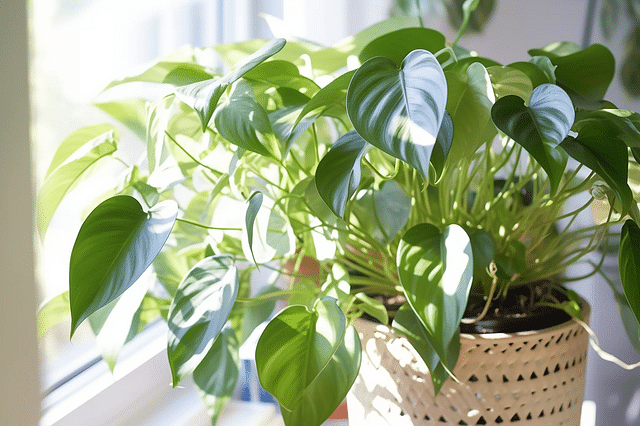
We've already discovered that Monsteras have natural holes in their leaves, but new Monstera leaves don't have those leaves just yet. So how do you know if you have a Monstera or a Philodendron?
Baby Monsteras typically have leaves that are solid and heart-shaped. These leaves still need to grow and won't have the holes just yet. The stems are smooth and relatively thin with small, brownish aerial roots emerging.
Initially, these stems will grow up straight. But once the leaf gets bigger and heavier, they’re likely to change into vining stems, looking for supports to grow against. Typically, you can use a moss pole to provide the support they need to keep growing upward.
Comparing the leaves
Young Monstera leaves might initially seem very similar to mature Philodendron leaves. However, there are certain clues you can pick up on to distinguish a new Monstera leaf from a mature Philodendron leaf.
First, look at the leaf's development. Unlike a Philodendron, a Monstera leaf will develop at least one fenestration, or hole, as it matures. So, if you see a leaf that looks like a Philodendron but starts developing holes as it grows, you can safely assume it's a Monstera.
New Monstera leaves have distinct characteristics that you can recognize. They usually have a lighter green color compared to mature leaves. Their structure is also very soft and flexible, and they are notably thin. So thin that you might feel like you can almost see through them.
So, by keeping an eye on these traits - the light green color, the soft and flexible structure, and the leaf's thinness - you can identify a young Monstera leaf, even before the iconic holes appear.
Comparing leaf sizes
Baby Philodendrons may have smaller but glossier leaves compared to Monsteras. This type of houseplant has stems with a uniform look to them that can have lavender, red, or coral hues. You'll spot thicker and more recognizable aerial roots growing along Philodendron stems.
Speed of growth
So the leaves can already tell you if you're dealing with a Philodendron or a Monstera, but you can also look at how quickly your plant grows. Monsteras are plants that grow moderately quickly and can put out 1-4 new leaves per year, depending on the size of the plant.
A Philodendron is a very quickly growing plant that can put out new leaves in a matter of weeks. It's also generally a more spread-out plant, whereas a Monstera tends to be a little bushier and more compact.
Monstera vs Philodendron Split-Leaf
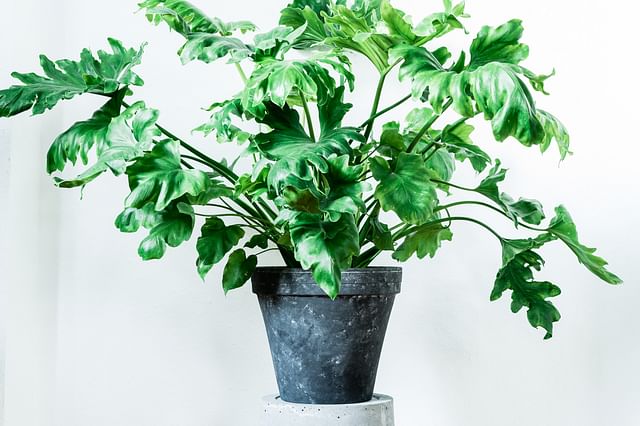
In the section about scientific names, we discovered that the Split-Leaf Philodendron is a common name for a Monstera Deliciosa and a Thaumatophyllum bipinnatifidum. So why have people chosen to call the Monstera Deliciosa a Philodendron?
There could be a few different reasons, but I think it's one of these two:
- The Monstera Deliciosa leaves look very similar to the leaves of a Thaumatophyllum bipinnatifidum (used to be called Philodendron bipinnatifidum). So at some point, people started calling both plants by the same nickname.
- Monsteras and Philodendrons are both part of the same family: Araceae. So this mix-up could've happened when the plants were initially identified. Some plants get misidentified and only years later this mistake gets fixed, but by that time it could already have a nickname that's hard to change.
So the Philodendron Split-leaf can be two different plants: A monstera deliciosa or a Thaumatophyllum bipinnatifidum. So how can you tell them apart?
Thaumatophyllum bipinnatifidum has large, deeply lobed (or 'split') leaves, but these leaves typically have smoother edges and a more glossy texture than that of a Monstera.
The lobes on a Thaumatophyllum bipinnatifidum leaf are more elongated and slender compared to Monstera's wider gaps. This type of Philodendron also grows upward and doesn't vine as a Monstera does.
A Monstera leaf doesn't just have split leaves, but it often also has holes in its leaves. This is something the leaves of the Thaumatophyllum bipinnatifidum won't have.
Philodendron Swiss Cheese vs Philodendron Adansonii vs Monstera Adansonii

Have you heard of the Monstera Monkey Leaf before? Or perhaps the Philodendron Swiss Cheese? I'm sure you've wondered if this plant is a Monstera or a Philodendron. This is one of my favorite plants because it has a lot of detail and many holes in the leaves, and the leaves are still relatively small and bushy plants.
By looking at the leaves and seeing the holes, you might already realize that the Philodendron Swiss Cheese plant is not a Philodendron, but a Monstera. So it's probably no surprise that the Philodendron Swiss Cheese is the same thing as the Monstera Adansonii.
So this beautiful little plant is a Monstera, but does the Philodendron Swiss Cheese still exists? The answer is, unfortunately, no. I also wish there was a Philodendron with the same look as this plant, but that hasn't been discovered yet.
Monstera adansonii, also called the Swiss Cheese Vine, is a unique houseplant from Central and South America. It's popular because of its holes in the leaves that look like Swiss cheese! They're smaller and more detailed than the other plant in its family, Monstera deliciosa.
If you give it something to attach itself to or lean on, it'll trail along and keep climbing. Of course, like other Monsteras, it also grows aerial roots to make sure it's stable when growing against something, like a moss pole.
Mini Monstera vs Monstera Minima vs Philodendron Minima?
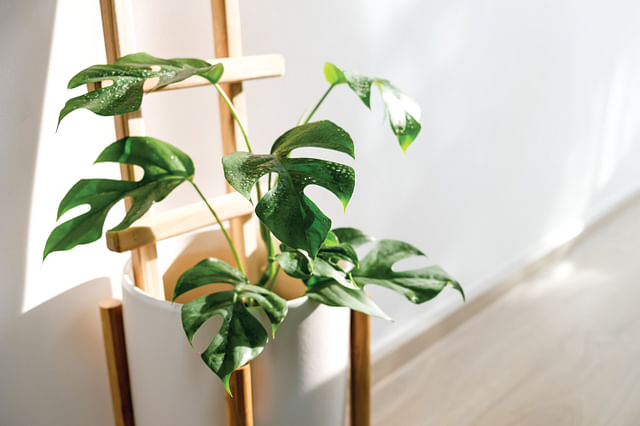
We've already discovered that two of the confusingly named plants are the same plant. So we'll continue that thought with the Mini Monstera, the Monstera Minima, the Philodendron Minima, Monstera Ginny, and Philodendron Ginnie. You guessed it, these are all the same plant. What makes it more interesting, at least for me, is that these nicknames are for a plant that's neither a Monstera or a Philodendron.
People use these nicknames for a plant called Rhaphidophora tetrasperma. It's a plant species that's native to Thailand and Malaysia and is also part of the Araceae family, just like a Monstera and a Philodendron.
This plant is called "mini" because of its smaller leaves compared to the Monstera deliciosa. The leaves look a lot like Monstera leaves with split leaves, so it's easy to mix it up with an actual Monstera.
Rhaphidophora tetrasperma has a vining habit and, like Monstera, produces aerial roots. Its leaves are glossy and have a more streamlined shape compared to the more rounded leaves of Monstera. The leaf splits of a Rhaphidophora tetrasperma do not reach the leaf edges, unlike Monstera deliciosa.
So the Rhaphidophora tetrasperma is not a Monstera nor a Philodendron, but is a different plant in the same family. Out of the two, the Rhaphidophora tetrasperma looks the most like a monstera and also grows like one. Here are some similarities between it and a Monstera:
Similarities between Rhaphidophora tetrasperma and Monstera
- Growth Habit: Both plants exhibit a vining growth habit and can either trail or climb based on the support they receive.
- Aerial Roots: Both produce aerial roots, which can help them climb on rocks or other trees.
- Split leaves: Both plants have natural holes and splits in their leaves.
Differences between Rhaphidophora tetrasperma and Monstera
- Size: Monstera leaves are large, with natural holes as they mature, giving them a unique look. The Rhaphidophora tetrasperma also has splits and holes in its leaves, but its leaves are much smaller. The Monstera overall is much larger in size than the Rhaphidophora tetrasperma.
- Care Requirements: While both plants enjoy similar conditions, Monsteras typically need more light to develop their signature fenestrations. Rhaphidophora tetrasperma however, can tolerate lower light conditions and is often considered easier to care for.
So now you know the difference between the Mini Monstera, the Monstera Minima, the Philodendron Minima, Monstera Ginny, and Philodendron Ginnie: There is none.
So far, we've seen 3 different plants that have a variety of confusing nicknames, which make it difficult to find proper plant care tips for your plant. This is why we'll look at some general plant care tips for keeping your Monstera, your Philodendron, Rhaphidophora tetrasperma, and even the Thaumatophyllum bipinnatifidum happy.
These plants aren't confused for each other for no reason: They are very similar to care for and all belong to the same plant family. So let's have a look at how we can take care of them.
Monstera vs Philodendron Care
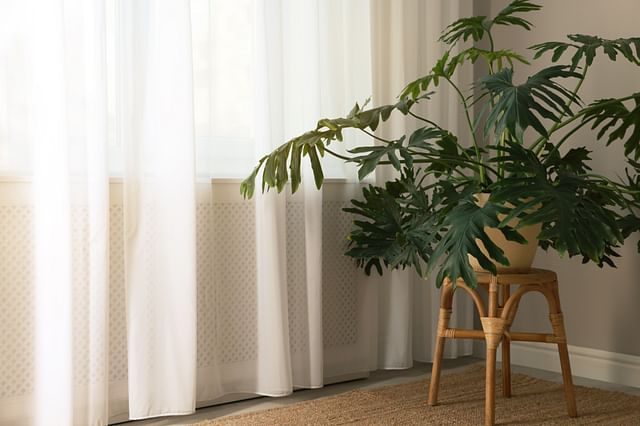
The different plants in this plant care guide are all different plants in the same family, so their care requirements, even though they're separate plants, are very similar. This is how you can take care of each of them:
Monstera Deliciosa
- Light: Bright, indirect sunlight
- Water: Allow soil to dry out partially between waterings
- Humidity: Prefers high humidity but can tolerate average household humidity
- Soil: Well-draining, peat-based potting mix
You can find more information about its care here: How to care for a Monstera.
Philodendron hederaceum 'Brasil'
- Light: Bright, indirect sunlight, but can tolerate low light conditions
- Water: Keep soil consistently moist but not waterlogged
- Humidity: Prefers high humidity but can tolerate average household humidity
- Soil: Well-draining, peat-based potting mix
You can find more information about its care here: How to care for a Philodendron.
Rhaphidophora tetrasperma
- Light: Bright, indirect sunlight
- Water: Allow soil to dry out partially between waterings
- Humidity: Prefers high humidity
- Soil: Well-draining, peat-based potting mix
You can find more information about its care here: How to take care of a Philodendron Minima.
Thaumatophyllum (was Philodendron) bipinnatifidum
- Light: Bright, indirect sunlight
- Water: Keep soil consistently moist but not waterlogged
- Humidity: Prefers high humidity but can tolerate average household humidity
- Soil: Well-draining, peat-based potting mix
You can find more information about its care here: How to Take Care of the Philodendron Selloum Hope.
As you can see, all of these plants prefer bright, indirect sunlight and like medium to high humidity levels to be happy. They also all prefer to grow in well-draining, nutrient-rich soil. This type of soil will keep these plants growing in a lightly moist environment, with lots of nutrients to absorb as energy.
There are some slight differences when it comes to watering these plants. The Monstera deliciosa and the Rhaphidophora tetrasperma like the top of the soil to dry out before being watered again, while the other two, the Philodendron hederaceum 'Brasil' and Thaumatophyllum bipinnatifidum would like to grow in soil that's always lightly moist.
Which is Better: Monstera or Philodendron?
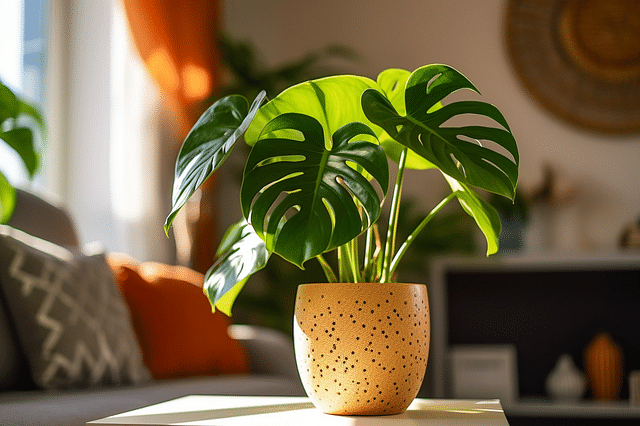
So which plant is better? There are a lot of different parts of a plant that might make it better for someone, but I'll focus on the ease of care. Which plant is the easiest to care for and the hardest one to kill? Which plant is the best one for beginners? Let's find out!
I don't think there is 1 clear winner, so I'll highlight the two plants that I think are the easiest to care for and the best plants for beginners out of these plants.
Monstera Deliciosa
If you're looking for a forgiving yet rewarding plant for any new plant owner look no further than the Monstera Deliciosa, also known as the Swiss Cheese Plant! It is very adaptable no matter where you live; it can handle both forgetting to water every once in a while and all types of light except direct sunlight. Not to mention, they grow quickly, giving others a striking visual reminder that their plant care efforts aren't going to waste. The only downside is they become large rather quickly, so if you don't have too much space at home, this might not be your ideal plant.
Philodendron hederaceum 'Brasil'
Philodendron hederaceum 'Brasil' is famous for being resilient and adaptable which means it can be happy in almost all types of light. Even if there's less natural light, this still won't be an issue! And if you're a bit forgetful with watering it, they can still do just fine.
The trailing shape of these plants makes them perfect for displaying in hanging baskets and popping on top of high shelves: anywhere you need to bring life to a room! And check out their vibrant variegated foliage too, it can really liven up a space.
So next time you're looking for plant tips, it can be a good idea to find the scientific name of your plant and use that for searching. This will help you get the most accurate plant care tips and will avoid a lot of confusion.
Thank you for reading this post! I hope it helps you to keep your plants healthy and beautiful! If you're looking for more guides on specific plants, you can always request a plant guide to get a guide for the plant you have trouble with.
Tags: Plant selection
Posted on: May 31, 2023